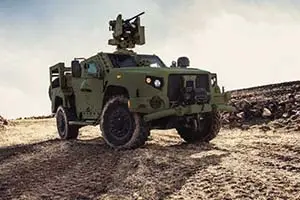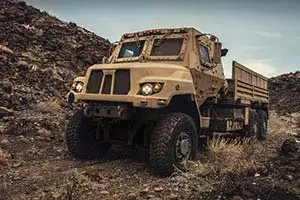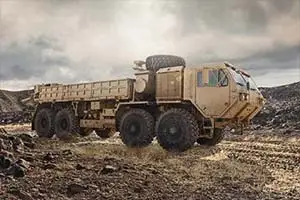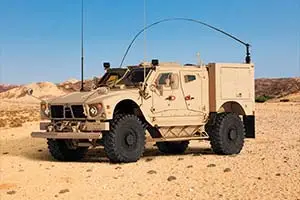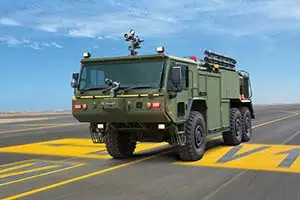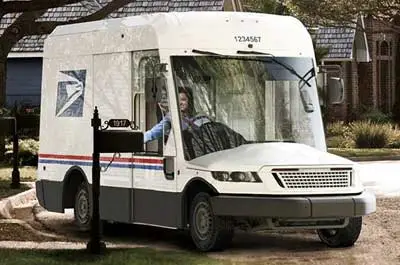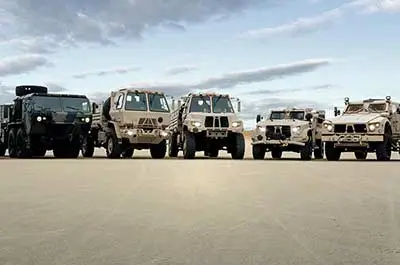OSHKOSH, Wis., Jan 23, 2006 — Oshkosh Truck Corporation (NYSE:OSK) announced today that it has unveiled an unmanned version of its Palletized Load System (PLS) vehicle at the U.S. Army Tactical Wheeled Vehicle Component Technology Demonstrations in Yuma, Ariz. Showcasing the immediate application of the technology for the U.S. Army fleet, Oshkosh is demonstrating a real-world mission scenario as the driverless truck transports cargo between destinations seven miles apart in the Arizona desert. The unmanned navigational kit being applied to the PLS was tested at the 2004 and 2005 DARPA Grand Challenge races, and has undergone additional testing in desert environments, similar to those in the Middle East. Oshkosh is partnered with Rockwell Collins (NYSE:COL) and the University of Parma, Italy, on the development of this unmanned navigational kit.
“It is Oshkosh Truck’s objective to always support the U.S. Army’s drive to integrate the most capable and reliable technologies into their fleet. To that end, we’re proud to make this next-generation of unmanned technology a reality that could be applied within the near term,” said John Stoddart, Oshkosh executive vice president and president of defense. “Our technology allows soldiers to be taken out of convoy resupply missions or to be re-assigned to other tasks within the convoy.”
The current “manned” Oshkosh(R) PLS transportation vehicle has proven its ability in front-line supply missions in Bosnia, Kosovo, Afghanistan and Iraq. A 10-wheel-drive truck and trailer system, the PLS is designed to transport containers carrying ammunition and other critical supplies, or large tanks holding fuel or water. The original PLS and the PLS Unmanned Ground Vehicle have a 16.5 ton payload capacity and an on-board material handling system that quickly unloads and loads cargo.
“Having helped the United States military move people and supplies for more than 80 years, Oshkosh understands the needs and challenges facing the armed services and are committed to helping the United States military lead the way in realizing the benefits of autonomous vehicle technology,” said Stoddart. “I believe this technology can revolutionize the transport of logistics in future conflicts and contribute to increased soldier survivability.”
Oshkosh Truck Corporation (NYSE:OSK) is a leading manufacturer of specialty trucks and truck bodies for the defense, fire and emergency, concrete placement and refuse hauling markets. Oshkosh Truck is a Fortune 1000 company with products marketed under the Oshkosh(R), Pierce(R), McNeilus(R), Medtec(TM), Geesink(R), Norba(R), Jerr-Dan(R), BAI, CON-E-CO(R) and London(R) brand names. The company is headquartered in Oshkosh, Wis., and had annual sales of $2.96 billion in fiscal 2005.
For more information about Oshkosh Truck Corporation, log onto the company web site at www.oshkoshtruckcorporation.com.
Forward-Looking Statements
This press release contains statements that the company believes are “forward-looking statements” within the meaning of the U.S. Private Securities Litigation Reform Act of 1995. All statements other than statements of historical fact, including statements regarding the company’s future financial position, business strategy, targets, projected sales, costs, earnings, capital spending and debt levels, and plans and objectives of management for future operations, are forward-looking statements. When used in this press release, words such as the company “expects,” “intends,” “estimates,” “anticipates,” or “believes” and similar expressions are generally intended to identify forward-looking statements. These forward-looking statements are not guarantees of future performance and are subject to risks, uncertainties, assumptions and other factors, some of which are beyond the company’s control, that could cause actual results to differ materially from those expressed or implied by such forward-looking statements. These factors include, without limitation, risks related to reductions in government expenditures, the uncertainty of government contracts, risks related to the Company’s acquisition strategy including identifying and evaluating acquisition candidates and integrating acquired businesses, and the possibility that expected synergies and other cost savings will not be achieved nor future plans realized. Additional information concerning these and other factors is contained in the Company’s filings with the Securities and Exchange Commission.
